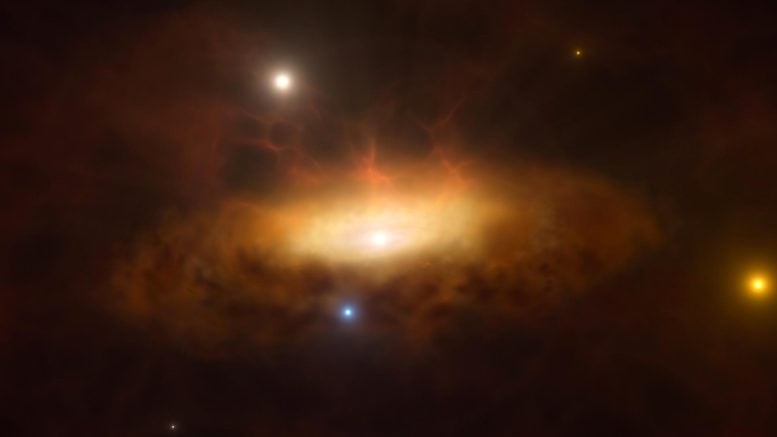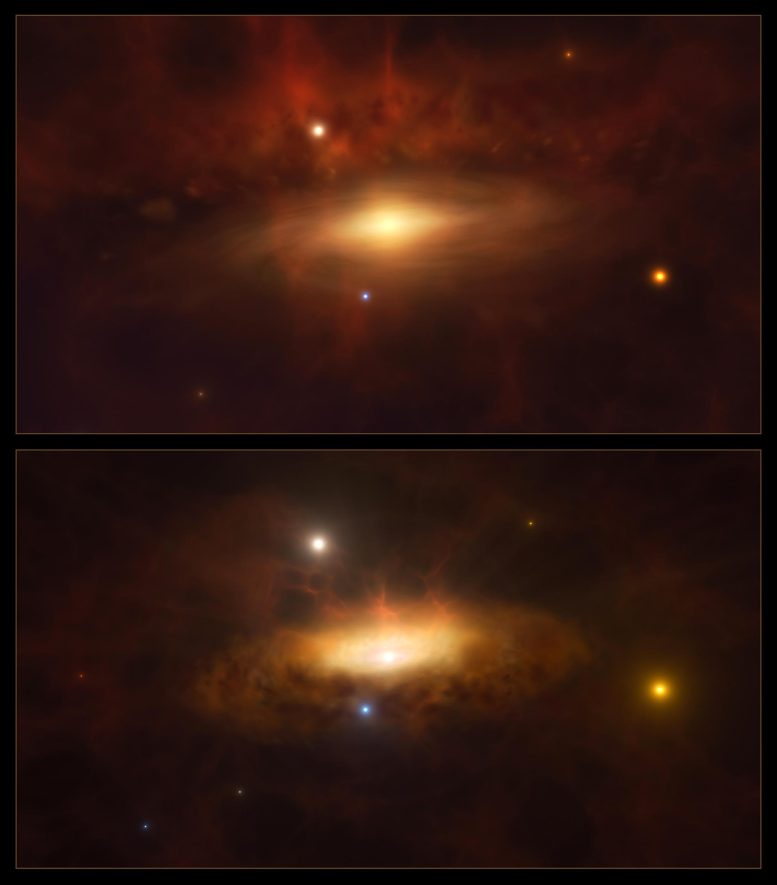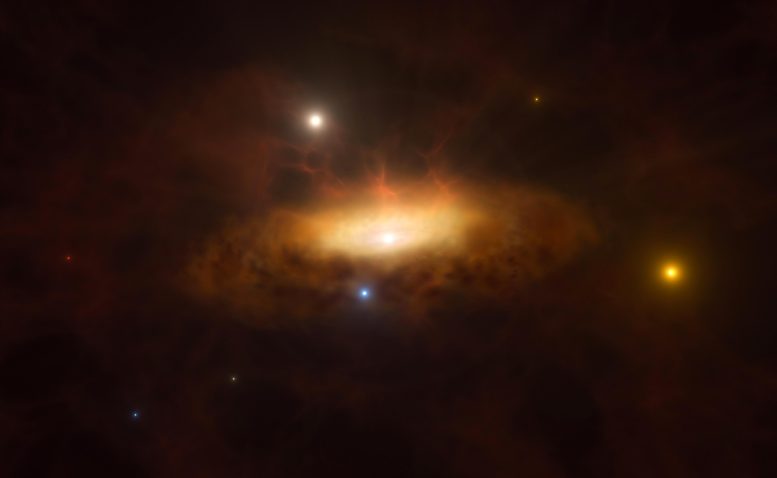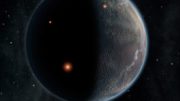
A galaxy named SDSS1335+0728 has shown continuous brightening since 2019, attributed to the activation of its central supermassive black hole, shedding light on how galactic nuclei become active. Credit: ESO/M. Kornmesser
The galaxy SDSS1335+0728, observed by the Very Large Telescope and others, has been exhibiting unprecedented brightness changes since December 2019, likely due to the activation of a supermassive black hole at its center.
This ongoing brightening offers a unique opportunity to study the transition from a quiescent state to an active galactic nucleus, which is a crucial phase that most galaxies with central black holes undergo.
Observations from several telescopes, including the European Southern Observatory’s Very Large Telescope (VLT) in the Atacama Desert in Chile, show a galaxy undergoing dramatic changes over the past several years. These dramatic changes in brightness began in December 2019, a phenomenon first noticed by the Zwicky Transient Facility (ZTF), which operates from the 48-inch Samuel Oschin Telescope at Caltech’s Palomar Observatory.
Unusual Brightness Phenomenon
Various phenomena can cause a temporary increase in brightness in a galaxy, including supernova explosions or tidal disruptions (when a star is torn apart as it passes close to a supermassive black hole). But the behavior of this galaxy, called SDSS1335+0728, is novel, at least compared to previous observations. Rather than brightening temporarily, for dozens or a few hundred days, the galaxy is still growing brighter today, more than four years after the change was first observed.
This video zooms into the galaxy SDSS1335+0728, which in late 2019 suddenly started shining brighter than ever before and was classified as having an active galactic nucleus. An inset at the end of the video shows an artist’s animation of the massive black hole at the center of the galaxy, with the growing disc of material being pulled in by the black hole as it feeds on the gas available in its surroundings. This is the first time the awakening of a massive black hole has been observed in real-time.
Insights Into Active Galactic Nuclei
The most likely explanation for this behavior is the turning on of a black hole at the center of SDSS1335+0728, though other explanations have not yet been ruled out. When supermassive black holes like this turn on, they are referred to as active galactic nuclei.
“We have found several million active galactic nuclei to date, and with the new generation of time-domain sky surveys like that at ZTF, we have found about 700 that are changing significantly in brightness,” Matthew Graham, research professor of astronomy at Caltech and project scientist for ZTF, explains. “But up to now, we have not observed any galactic nuclei that are in the actual process of turning on, of transitioning from a quiescent state to an active state with material falling into the supermassive black hole at the heart of the galaxy.”

This artist’s impression shows two stages in the formation of a disc of gas and dust around the massive black hole at the centre of the galaxy SDSS1335+0728. The core of this galaxy lit up in 2019 and keeps brightening today — the first time we observe a massive black hole become active in real time. Credit: ESO/M. Kornmesser
Future Research Directions
New observations from ESO’s VLT and other locations show SDSS1335+0728 is radiating more ultraviolet, optical, and infrared light, and most recently, X-rays.
“As far as we can tell,” Graham says, “there is nothing particularly unusual about this galaxy. We’ve just caught it at a somewhat unique moment. We expect most galaxies go through a phase like this since most galaxies have a supermassive black hole at their center. Further study of this galaxy will help us to better understand this process and also help us find other examples.”
This animation shows the growing disc of material around the massive black hole at the center of the galaxy SDSS1335+0728. In late 2019 this galaxy suddenly started shining brighter than ever before and was classified as having an active galactic nucleus, powered by the central black hole feeding off the surrounding material. Credit: ESO/M. Kornmesser
This research was published in Astronomy & Astrophysics under the title “SDSS1335+0728: The awakening of a ∼106M⊙ black hole.”
For more on this research, see Witnessing a Massive Black Hole’s Dramatic Awakening.
Reference: “SDSS1335+0728: The awakening of a ~10^6 M⊙ black hole” by P. S’anchez-‘aez, L. Hernandez-Garcia, S. Bernal, A. Bayo, G. Calistro Rivera, F.E. Bauer, C. Ricci, A. Merloni, M.J. Graham, R. Cartier, P. Arevalo, R.J. Assef, A. Concas, D. Homan, M. Krumpe, P. Lira, A. Malyali, M.L. Martínez-Aldama, A.M. Munoz Arancibia, A. Rau, G. Bruni, F. Forster, M. Pavez-Herrera, D. Tubin-Arenas and M. Brightman, 18 June 2024, Astronomy & Astrophysics.
DOI: 10.1051/0004-6361/202347957










Be the first to comment on "Massive Black Hole Awakening Sheds Light on Galactic Behavior"